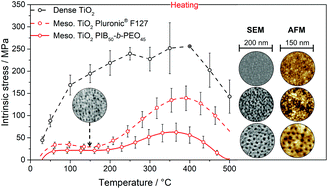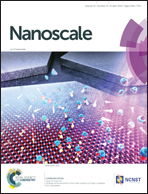In-plane stress development in mesoporous thin films†
Abstract
Ordered mesoporous thin films of TiO2 and CexZr1−xO2 (x = 0, 0.5, 1) were prepared via an evaporation-induced self-assembly (EISA) process and subsequently investigated in terms of the developing intrinsic and residual in-plane stress. These mechanical properties were determined by the curvature method, which is based on the determination of the deflection of light due to concave or convex bending of the films on a substrate. The films were investigated with regard to the intrinsic stress during heat treatment up to 500 °C and to the residual stress at room temperature for several annealing temperatures. Following this strategy, the influence of the decomposition of a block copolymer template on the intrinsic stress as well as the pore collapsing on the residual stress was analyzed. Nanoporous TiO2 thin films were prepared using two different block copolymers (PIB50-b-PEO45 and Pluronic® F127). A comparison between the templated and non-templated TiO2 films showed the lowest intrinsic and residual stress for the ordered mesoporous material prepared with PIB50-b-PEO45 indicating that the distributed polymer and the corresponding mesopores act as relaxing agents for the system. This was verified by mesoporous CexZr1−xO2 (x = 0, 0.5, 1) thin films showing a comparable behavior in terms of the experienced intrinsic stress. This work reveals an increase in the residual in-plane stress during pore collapse, which lays the foundation for further understanding of the stress-related mechanical properties of mesoporous thin films.



 Please wait while we load your content...
Please wait while we load your content...